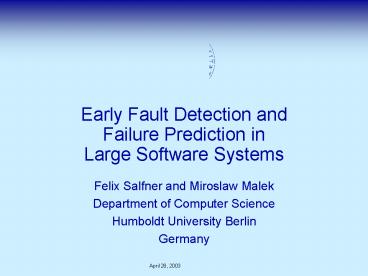Early Fault Detection and Failure Prediction in Large Software Systems - PowerPoint PPT Presentation
1 / 12
Title:
Early Fault Detection and Failure Prediction in Large Software Systems
Description:
Salfner, Malek -- Humboldt University Berlin. 2. Outline. Our goal. Description of the model ... Salfner, Malek -- Humboldt University Berlin. 3 ... – PowerPoint PPT presentation
Number of Views:183
Avg rating:3.0/5.0
Title: Early Fault Detection and Failure Prediction in Large Software Systems
1
Early Fault Detection and Failure Prediction in
Large Software Systems
- Felix Salfner and Miroslaw MalekDepartment of
Computer ScienceHumboldt University
BerlinGermany
2
Outline
- Our goal
- Description of the model
- Validation of the model
- Two applications using the failure predictor
- Work in progress
- Conclusions
3
Our Goal Highly-Available Component-Based
Software Systems
Event-logs
System
Event type
High levelfailure prediction
t
Comp 1
Comp 2
Comp 3
Faultdetection
Res b
Res a
Res c
4
Mathematical Model View
Stochastic Occurrence of Faults
System
Failures
t Dt
t
t
t
t
TS 1
TS n
Errors
Failure prediction
Faultdetection
Model
t Dt
t - Dt
5
Model Description
- The model contains patterns of events
- Failure prediction patterns that lead to
failures. - Early fault detection patterns that identify and
locate faults. - Patterns reflect temporal behavior of the system.
- Patterns are modeled as paths in an acyclic
directed graph. - Events are characterized by multiple system
properties. - Two-phase approach
- Model construction
- Analyze system behavior with the help of past
logfiles. - Extract patterns by means of clustering
algorithms. - Construct a generalized model.
- Model application
- Wait for the occurrence of events.
- Check whether the event matches known patterns
(paths). - If true, calculate probability and timeframe for
every path.
6
Model construction
- Identify target positions in a logfile
- Cut out segments preceding the target positions
(extract history) - Each segment forms one path in the graph
- Group events by means of clustering algorithms
- Simplify the graph
- Calculate relative likelihoods of branches
7
Model application
- ExampleMeasure memory usage each time an event
occurs - Two types of failures
- No process memory available
- No shared memory available
8
Validation of the model
- Focus on
- Telecommunication system such as ATT or Siemens
- Large software system
- Component / container based software architecture
- Distributed computing system (5 5000 Servers)
- Large data set 500MB per day of operation
- Validation of selected paths by domain experts
9
Failure Specific Dynamic Recovery
Checkpointing
- Failure specific recovery scheme
- Risk levels for different failure types
- Dynamic Recovery
- Low risk
- Predicted probability of failure occurrence is
below risk level - Leave out checkpointing and acceptance test
- Reduce computational overhead
- Gain efficiency
- High risk
- Predicted probability of failure occurrence is
above risk level - Checkpointing and acceptance test have to be
carried out - Reduce lost computation in case of failure
Acceptance test
Checkpointing
Acceptance test
Checkpointing
Acceptance test
10
Evaluating Proactive Measures
- Patterns describe system behavior in the presence
of faults - How does the system usually run into failure
situations? - Proactive techniques take countermeasures to
prevent the system from running into failure
situations. - The model facilitates evaluation of proactive
measures while they are applied to a running
system.
11
Work in Progress
- Online learning
- Include new patterns when failures are identified
- Prune nodes that are rarely used
- Integration of health paths
- Include cases where no failure occurred
- Introduce probability densities to nodes
- Now Ranges for node parameters
- Future Probability densities
- A paths probability also depends on the
deviation from the center of a given distribution
12
Conclusions
- Temporal system behavior is directly incorporated
into the model. - Calculations during the models application can
be performed effectively. Only a
depth-first-search with a few additional
multiplications and additions is needed. - The model is intuitive since paths express
correlations in a formalism that is easily
understandable. - It is extensible to a hybrid model since it can
be supplemented by paths obtained from classic
system analysis (within one model).

